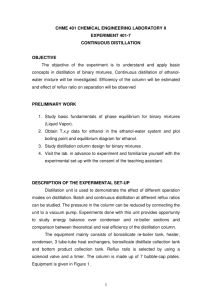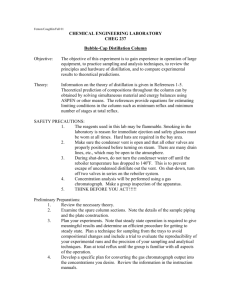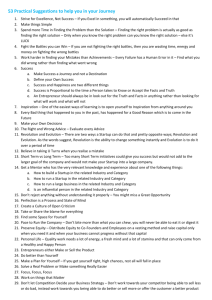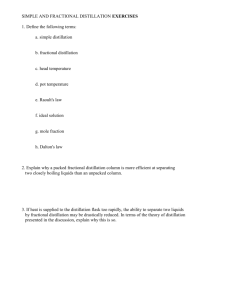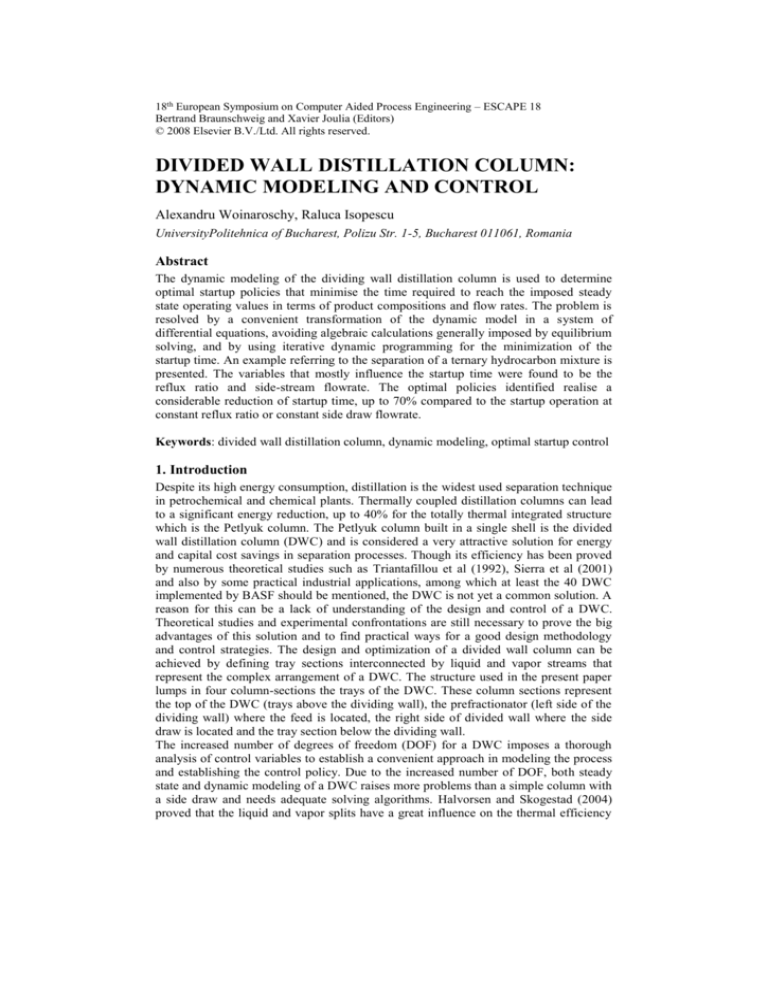
18th European Symposium on Computer Aided Process Engineering – ESCAPE 18
Bertrand Braunschweig and Xavier Joulia (Editors)
© 2008 Elsevier B.V./Ltd. All rights reserved.
DIVIDED WALL DISTILLATION COLUMN:
DYNAMIC MODELING AND CONTROL
Alexandru Woinaroschy, Raluca Isopescu
UniversityPolitehnica of Bucharest, Polizu Str. 1-5, Bucharest 011061, Romania
Abstract
The dynamic modeling of the dividing wall distillation column is used to determine
optimal startup policies that minimise the time required to reach the imposed steady
state operating values in terms of product compositions and flow rates. The problem is
resolved by a convenient transformation of the dynamic model in a system of
differential equations, avoiding algebraic calculations generally imposed by equilibrium
solving, and by using iterative dynamic programming for the minimization of the
startup time. An example referring to the separation of a ternary hydrocarbon mixture is
presented. The variables that mostly influence the startup time were found to be the
reflux ratio and side-stream flowrate. The optimal policies identified realise a
considerable reduction of startup time, up to 70% compared to the startup operation at
constant reflux ratio or constant side draw flowrate.
Keywords: divided wall distillation column, dynamic modeling, optimal startup control
1. Introduction
Despite its high energy consumption, distillation is the widest used separation technique
in petrochemical and chemical plants. Thermally coupled distillation columns can lead
to a significant energy reduction, up to 40% for the totally thermal integrated structure
which is the Petlyuk column. The Petlyuk column built in a single shell is the divided
wall distillation column (DWC) and is considered a very attractive solution for energy
and capital cost savings in separation processes. Though its efficiency has been proved
by numerous theoretical studies such as Triantafillou et al (1992), Sierra et al (2001)
and also by some practical industrial applications, among which at least the 40 DWC
implemented by BASF should be mentioned, the DWC is not yet a common solution. A
reason for this can be a lack of understanding of the design and control of a DWC.
Theoretical studies and experimental confrontations are still necessary to prove the big
advantages of this solution and to find practical ways for a good design methodology
and control strategies. The design and optimization of a divided wall column can be
achieved by defining tray sections interconnected by liquid and vapor streams that
represent the complex arrangement of a DWC. The structure used in the present paper
lumps in four column-sections the trays of the DWC. These column sections represent
the top of the DWC (trays above the dividing wall), the prefractionator (left side of the
dividing wall) where the feed is located, the right side of divided wall where the side
draw is located and the tray section below the dividing wall.
The increased number of degrees of freedom (DOF) for a DWC imposes a thorough
analysis of control variables to establish a convenient approach in modeling the process
and establishing the control policy. Due to the increased number of DOF, both steady
state and dynamic modeling of a DWC raises more problems than a simple column with
a side draw and needs adequate solving algorithms. Halvorsen and Skogestad (2004)
proved that the liquid and vapor splits have a great influence on the thermal efficiency
2
A. Woinaroschy et al.
of the DWC. More recently, Wang and Wong (2007) demonstrated that outside a given
region defined by certain liquid and vapor split values, the composition control can
compensate only for variation in feed characteristic, such as feed or composition, but
not for internal flow changes. They proposed a temperature-composition cascade
scheme to control a DWC. Temperature control strategies proved to be efficient also for
complex schemes including heterogeneous azeotropic distillation and a DWC (Wang et
al 2008). Startup policies must be considered as well when analysing the efficiency of a
DWC. In order to promote the generalisation of DWC in industrial application it is
necessary to provide reliable design methodologies and convenient start up strategies of
the column.
In order to promote the generalisation of DWC in industrial application it is necessary
to provide reliable design methodologies, but it is also very important to define
strategies for a convenient startup of the column. The present paper proposes a new
dynamic model for a DWC and applies it to formulate the startup control.
2. Dynamic Distillation Model (DDM)
The DDM proposed by Woinaroschy (1986, 2007) represents a good compromise
between the degree of complexity and correctness. The advantage and originality of the
selected model consist in the fact that the iterative algebraic equations are avoided. The
core of the model consists in the following system of ordinary differential equations
(with the usual notations for distillation field):
Total mass balance around plate j:
dN j
dt
L j 1 V j 1 L j V j FL , j FV , j
(1)
Component mass balance around plate j for component i:
d ( N j xi , j )
dt
L j 1 xi , j 1 V j 1 yi , j 1 L j xi , j V j yi , j FL , j x F ,i , j FV , j y F ,i , j
(2)
Original equation for dynamic calculation of temperature on plate j:
m
dT j
dt
i 1
i , j Pi , j
pj
m
i 1
x d i , j
1 i , j
dx
i, j
i, j
xi , j i , j dPi , j
pj
dxi , j
dt
(3)
dT j
The state variables are Nj, j=1,2..n; xi,j, i=1,2..m-1, j=1,2..n; and Tj, j=1,2..n.
The variation of total pressure during each time integration step is much smaller than
the variations of composition and temperature. In order to simplify the procedure, the
vapor pressure on each tray is considered constant along the time integration step, but it
will be recomputed at the beginning of the new time step. The tray pressure drop is
calculated on the base of hydraulic correlations, specific for the plate type.
Vapor flow rate Vj is obtained from total energy balance and the vapor composition is
calculated according to Murphree efficiency. Liquid flow rate Lj is computed on the
base of Francis' correlation for the corresponding plate weir. The equilibrium,
Divided Wall Distillation Column: Dynamic Modeling and Control
3
thermodynamic data, and other physical properties correlations are selected in function
of the mixture nature. The system of differential equations was numerically integrated
by fourth order Runge-Kutta-Gill method, the DDM being coded in FORTRAN.
3. Example
A mixture of three components (60% benzene, 30% toluene and 10% ethylbenzene) is
separated in a DWC with sieve plates and lateral downcomers. The vapor pressures Pi,j
of components were calculated on the basis of Antoine equation, and the trays
efficiency was set at value 1 (equilibrium trays).
3.1. Design of the divided wall column.
The next column parameters were imposed as follows: feed specification: liquid at
bubble point; feed flow rate: 0.0053 kmol s-1; side stream flow rate: 0.001455 kmol s-1;
type of condenser: total; condenser pressure: 760 mm Hg; reflux ratio: 3; type of
reboiler: total; reboiler heat duty: 417 kW; bottom liquid volume: 0.146 m3; tray surface
(for top and bottom sections): 0.451 m2; tray surface (for right and left side of the
dividing wall): 0.2255 m2; weir height: 0.025 m; hole diameter: 0.002 m.
Using DDM (searching the values at final, stationary state) were established by several
iterations the number of trays for the column sections, the location of the feed and side
streams and the fraction of liquid flowing in the right hand side of the dividing wall.
This iterative search was made in order to obtain the best separation of each component.
The corresponding values are: Number of trays: top section: 6; left side: 15; right side:
15; bottom section: 13; Feed stream location: the 2nd from the top of the left side; Side
stream location: the 3rd from the top of the right side; Fraction of liquid flowing in the
right hand side of the dividing wall: 0.45. In these conditions the components’ mole
fractions in the products are: 0.9564 benzene in the top product, 0.970 toluene in the
side product and 0.9340 ethylbenzene in the bottom product.
3.2. Optimal startup control.
Startup of distillation columns is a very challenging control and simulation problem due
to both theoretical and practical aspects. A general sequence of actions which forms the
basis for different startup procedures was formulated by Ruiz et al (1988). At the end of
several preliminary actions all plates have enough liquid holdup, so that the liquid can
start to fall down the downcomers. The downcomers are sealed and no vapor can go up
through them. The liquid composition is the same on all plates, being equal with the
feed composition. In the frame of present work these conditions define the initial state
from which begins the effective startup transient operating regime procedure.
Traditionally, the column is operated at constant values of control parameters. Usually,
these are the prescribed values for the desired stationary regime. In an optimal transient
regime procedure the column will be operated at prescribed time-distributed values of
control parameters, in order to minimize the duration of the transient regime. In fact,
optimal startup control consist in reaching a desired final state from a set of given initial
condition in minimum time by an adequate control policy. That means minimization of
the penalty performance index formulated as:
ns
si (t f )
i 1
s si
1
I tf
ns
(4)
4
A. Woinaroschy et al.
where tf is the final time, ω > 0 is a penalty coefficient, ssi are the desired final
stationary state values, and the final values of state variables si (tf ), i = 1,2,…ns are
calculated by integration of equations (1)-(3). Minimization of the penalty performance
index is made through control variables ui subject to the bounds:
umin i ui umax i
i 1, 2..., nu
(5)
A set of DDM simulations indicated that the more suitable control parameters for the
optimal startup of the divided wall distillation columns are the reflux ratio and the sidestream flowrate. The task of optimal startup control of the DWC was solved using the
algorithm proposed by Bojkov and Luus (1994), based on the iterative dynamic
procedure given by Bojkov and Luus (1992, 1993) which employs randomly chose
candidates for the admissible control. The algorithm was applied for 5 time stages. The
grid points number for state-grid was 5, 9 for policy-grid, and 9 for piece time-grid. The
region contraction factor was set at 0.8, and the total number of iterative dynamic
procedure iterations was 10.
The startup time for optimal reflux control is 120 min. and for side-stream flowrate
control is 130 min. These results (for each case obtained after 44805 numerical
integrations of the system (1)-(3) with 200 differential equations) are remarkable in
comparison with operating at constant control parameters where the startup time is 380
min. For all these regimes the final stationary state corresponds to an average value of
the normalized derivatives less than 10-6 (maximum integration step is 1 s.).
In figures 1 and 2 are presented the optimal reflux control and the optimal side-stream
flowrate control (subscript s indicates final, stationary value).
Figure 1. Optimal reflux control
Figure 2. Optimal side-stream flowrate control
The selected control variables (reflux or side-stream flowrate) can be easily manipulated
in practical applications. In a DWC the reflux must be high enough to build-up the
reflux on both sides of the dividing wall. The value of the reflux ratio strongly modifies
the separation on both sides of the diving wall and hence it will affect the concentration
profiles along the trays. Not only the distillate and bottom product will be influenced by
the variation of reflux ratio, but also the side-stream which is desired to contain the
intermediate component at very high concentration. This consideration can lead to the
conclusion that a correct reflux policy will bring the DWC in stable operating condition
in a reasonable time. The liquid split which is a means of controlling the side draw
purity (Mutalib and Smith, 1998) was imposed at the value obtained in steady state as
the feed composition did not vary in the present study. The influence of the liquid split
Divided Wall Distillation Column: Dynamic Modeling and Control
5
variation along the startup period had an insignificant influence on the startup time. As
regarding the vapor split it was left to adjust naturally according to the temperature
distribution along the trays and pressure drop.
In figures 3 and 4 are presented the evolutions of components’ mole fractions in the top
and bottom products. In figure 3 the evolution of the benzene concentration in the top
product at constant control parameters and at optimal side-flowrate control overlaps (for
the entire time domain of optimal side-flowrate control, respectively 130 min.).
It can be observed that the responses in the bottom concentrations are determinant for
the values of startup time, as it was expected.
Figure 3. Evolution of benzene concentration in the top product for startup at constant control
parameters and at optimal side-flowrate control ( ― ), and at optimal reflux control (---).
Figure 4. Evolution of ethylbenzene concentration in the bottom product for startup at constant
control parameters (― ), at optimal reflux control (---) and at optimal side-flowrate control (– ∙ –).
6
A. Woinaroschy et al.
4. Discussion
The selected value for the number of time stages to 5 seems to be too small. A higher
value of this number increases drastically the CPU time, without a substantial
improving of the performance index (Luus, 1989; Luus and Galli, 1991). In the case of
side-stream flowrate control, the increase to 10 of the number of time stages have
reduced the startup time only with one minute, but the corresponding control policy is
more complicated. The attempt to find the optimal startup control of the divided wall
column with other optimization techniques (Luus-Jaakola, Hooke-Jeeves) failed. As in
the case of startup optimization of classical distillation columns (Woinaroschy, 2007) it
is possible to avoid the undesirable secondary bang-bang effects of the piecewise
constant control by replacing it with piecewise linear control.
5. Conclusions
The dynamic model proposed proved to represent well the separation in a DWC of a
ternary hydrocarbon mixture. The values of internal flows and temperature distributions
along the trays reached at steady state were in good agreement with the simulations
obtained in the frame of commercial simulators. The use as control variables the reflux
ratio or the side-stream flowrate proved to enable a reduction of the startup time with
about 70 % compared with classical startup procedures. The complex technique
developed can be a useful tool in studying dynamic behavior and startup optimization
for complex columns and can be easily extended to various mixtures.
References
B. Bojkov, R. Luus, 1992, Use of Random Admissible Values for Control in Iterative Dynamic
Programming, Ind. Eng. Chem. Res., vol. 31, p.1308
B. Bojkov, R. Luus, 1993, Evaluation of the Parameters Used in Iterative Dynamic Programming,
Can. J. Chem. Eng., vol. 71. p. 451
B. Bojkov, R. Luus, 1994, Time-Optimal Control by Iterative Dynamic Programming, Ind. Eng.
Chem. Res., vol. 33, p.1486
I. J. Halvorsen, S. Skogestad, 2004, Shortcut Analisys of Optimal Operation of Petliuk
Distillation, Ind. Eng. Chem. Res., vol. 43, p.3994
R. Luus, 1989, Optimal Control by Dynamic Programming Using Accessible Grid Points and
Region Reduction, Hung. J. Ind. Chem., vol. 17, p.523
R. Luus, M. Galli, 1991, Multiplicity of Solutions in using Dynamic Programming for Optimal
Control, Hung. J. Ind. Chem., vol. 19, p. 55
M. I. A. Mutalib, R. Smith, 1998, Operation and Control of Dividing Wall Distillation Columns,
Trans IchemE, vol. 76, part A, p. 318
C. A. Ruiz, I. T. Cameron, R. Gani, 1988, A Generalized Model for Distillation Columns III.
Study of Startup Operations, Comput. Chem. Eng., vol. 12, p. 1
M. Serra, M. Perrier, A. Espuna, L. Puigjaner, 2000, Study of the Divided Wall Column
Controlabillity: Influence of the Design and Operation, Comput. Chem. Eng., vol. 24, p. 901
C. Tryantafillou, R. Smith, 1992, The Design and Optimisation of Fully Thermally Coupled
Distillation Columns, TransIChemE, part A, Chem. Eng. Res. Des., vol. 70(A5), p. 118
S. J. Wang, D. Wong, 2007, Controllability and energy efficiency of high purity divided wall
column, Chem. Eng. Sci., vol. 62, p. 1010
S. J. Wang, C. J. Lee, S. S. Jang, S. S. Shien,2008, Plant-wide design and control of acetic acide
dehydration system via heterogeneous azeotropic distillation and divided wall distillation, J.
Process Control, vol. 18, p. 45
A. Woinaroschy, 1986, A New Model for the Dynamic Simulation of the Rectification Processes.
I. Development of the Mathematical Model and Algorithm, Rev. Chim., vol. 37, p. 697
A. Woinaroschy, 2007, Time-Optimal Control of Distillation Columns by Iterative Dynamic
Programming, Chem. Eng. Trans., vol. 11, p. 253

